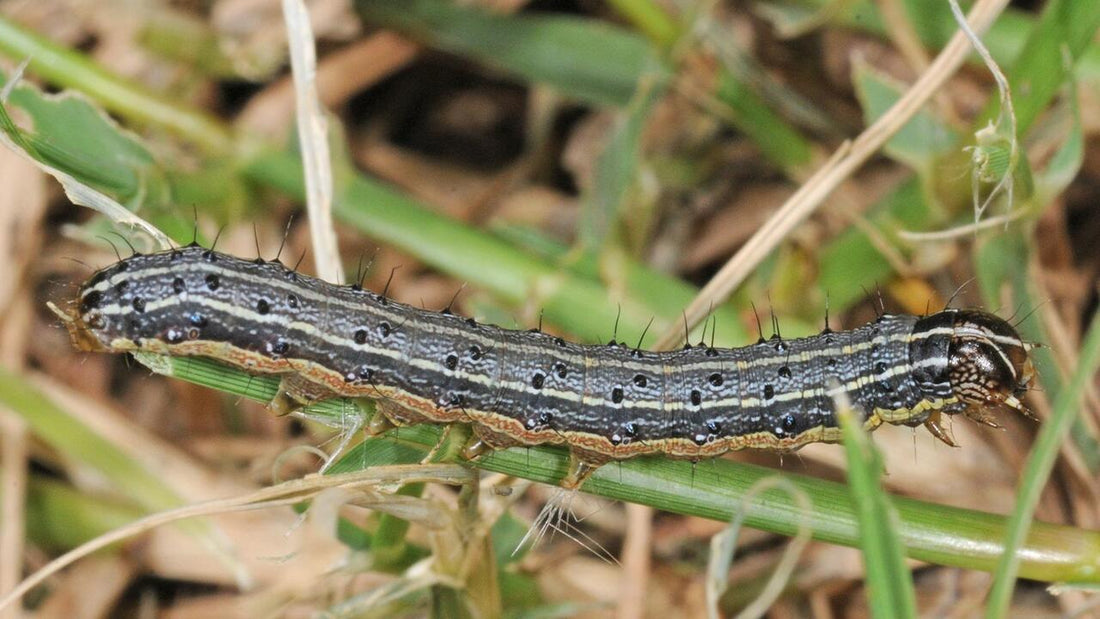Armyworms are one of the most destructive lawn and garden pests we face in Mississippi, especially from late summer into early fall. These caterpillars can strip grass and crops almost overnight—sometimes leaving entire patches of lawn looking like they’ve been scalped.
They’re called “armyworms” because they move together in large groups, marching across lawns and fields like an army, eating everything in their path.
How to Identify Armyworms
Armyworms are the caterpillar stage of a moth. The adult moths lay clusters of eggs on grass blades, fences, or even patio furniture. Once the eggs hatch, the larvae (caterpillars) begin feeding aggressively.
-
Color: Armyworms are usually green, brown, or black with stripes running lengthwise down their bodies.
-
Size: They grow up to about 1 ½ inches long.
-
Markings: Look for a distinct inverted “Y” shape on the head—this is a key way to tell them apart from other caterpillars.
Most of the feeding damage happens in the caterpillar stage, before they pupate in the soil and emerge as moths to repeat the cycle.
Signs of Armyworm Damage
-
Lawn suddenly looks brown or scalped. They can eat grass blades down to the crown in a matter of days.
-
Uneven patches of grass. Damage often starts in sunny areas and spreads quickly.
-
Increased bird activity. Birds may flock to your lawn to feed on the worms.
-
Caterpillars visible at dawn or dusk. Armyworms are most active early and late in the day.
If you suspect armyworms, mix up a bucket of soapy water and pour it onto a small patch of grass. If worms are present, they’ll quickly wriggle to the surface.
How to Get Rid of Armyworms
Catching infestations early is key—once they move in, damage happens fast.
-
Inspect often. Check your lawn daily in late August through October, when armyworms are most active.
-
Encourage birds and beneficial insects. Natural predators help keep populations down.
-
Treat at the first sign. Young armyworms are much easier to control than larger ones.
Control Options
-
Natural / First-Line Treatments:
-
Ferti-Lome Green Spinosad Concentrate – Mix 2 oz per gallon of water and spray over the lawn. Works well on young caterpillars and is an organic option.
-
-
Stronger Systemic or Lawn Treatments:
-
Hi-Yield 38 Plus Turf, Termite, & Ornamental Insect Control – A broad-spectrum treatment effective against heavy infestations. Follow label directions for lawn application.
-
Ferti-Lome Systemic Insect Spray – Mix 1½ teaspoons per gallon of water and apply as a foliar spray for continued protection.
-
Prevention Tips
-
Water deeply, but don’t overwater. Stressed lawns are more vulnerable.
-
Keep grass healthy. A well-fertilized, well-maintained lawn bounces back faster from damage.
-
Stay on top of fall lawn care. Since armyworm season overlaps with overseeding and prep, check before reseeding so young grass isn’t wiped out.
The Bottom Line
Armyworms can devastate a lawn in days, but with regular inspection and timely treatment, you can stop them before they cause serious damage. Keep an eye out from late August through early fall, and be ready to treat quickly if you spot them marching across your yard.


